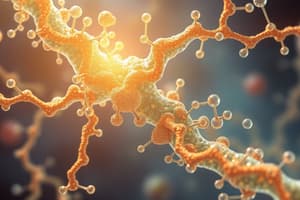Podcast
Questions and Answers
What is the primary amino acid residue where N-linked oligosaccharides are covalently linked to proteins?
What is the primary amino acid residue where N-linked oligosaccharides are covalently linked to proteins?
- Tyr
- Asn (correct)
- Gly
- Ser
During which cellular process are N-linked sugars typically attached to proteins in the form of a 14 residue oligosaccharide?
During which cellular process are N-linked sugars typically attached to proteins in the form of a 14 residue oligosaccharide?
- Translation (correct)
- Replication
- Translation and Transcription
- Transcription
Which of the following statements accurately describes the process of N-linked glycosylation?
Which of the following statements accurately describes the process of N-linked glycosylation?
- It occurs in the endoplasmic reticulum. (correct)
- It begins in the Golgi apparatus.
- It occurs exclusively in the cytoplasm.
- Oligosaccharides are added one sugar at a time.
In the context of glycoproteins, what role do peptidoglycans play?
In the context of glycoproteins, what role do peptidoglycans play?
Which of the following is NOT a mechanism by which oligosaccharides can attach to proteins?
Which of the following is NOT a mechanism by which oligosaccharides can attach to proteins?
What characterizes the recognition site for N-linked glycosylation?
What characterizes the recognition site for N-linked glycosylation?
What type of polysaccharide is heparin classified as in terms of glycoproteins?
What type of polysaccharide is heparin classified as in terms of glycoproteins?
What modification occurs to glycoproteins in the Golgi apparatus?
What modification occurs to glycoproteins in the Golgi apparatus?
Which statement correctly describes the role of sialic acids in biochemistry?
Which statement correctly describes the role of sialic acids in biochemistry?
What type of bond is formed by the reaction between an alcohol and the anomeric center of a carbohydrate?
What type of bond is formed by the reaction between an alcohol and the anomeric center of a carbohydrate?
What characterizes a reducing sugar in the context of saccharides?
What characterizes a reducing sugar in the context of saccharides?
In N-linked glycosylation, which amino acid is primarily involved in the attachment of oligosaccharides?
In N-linked glycosylation, which amino acid is primarily involved in the attachment of oligosaccharides?
Which of the following defines a glucoside?
Which of the following defines a glucoside?
What is the structural characteristic of D-allose as an aldohexose?
What is the structural characteristic of D-allose as an aldohexose?
Which modification prevents -D-allopyranose from mutarotating?
Which modification prevents -D-allopyranose from mutarotating?
Which of the following amino acids is NOT typically involved in O-linked glycosylation?
Which of the following amino acids is NOT typically involved in O-linked glycosylation?
What structural feature differentiates hyaluronic acid from other glycosaminoglycans?
What structural feature differentiates hyaluronic acid from other glycosaminoglycans?
Which amino acid is commonly involved in the attachment of O-linked oligosaccharides?
Which amino acid is commonly involved in the attachment of O-linked oligosaccharides?
What type of proteins specifically bind to carbohydrates?
What type of proteins specifically bind to carbohydrates?
In the context of glycoproteins, what type of glycosylation involves the attachment of sugars to nitrogen atoms?
In the context of glycoproteins, what type of glycosylation involves the attachment of sugars to nitrogen atoms?
Which sugar configuration indicates most carbohydrates in living organisms are in the D-form?
Which sugar configuration indicates most carbohydrates in living organisms are in the D-form?
What is the primary structural feature of hyaluronic acid?
What is the primary structural feature of hyaluronic acid?
Which amino acid's hydroxyl group can form O-linked glycosidic bonds in glycoproteins?
Which amino acid's hydroxyl group can form O-linked glycosidic bonds in glycoproteins?
What is the significance of the specific carbohydrate-binding proteins in biological systems?
What is the significance of the specific carbohydrate-binding proteins in biological systems?
Which type of glycosylation is characterized by the attachment of oligosaccharides to serine or threonine residues?
Which type of glycosylation is characterized by the attachment of oligosaccharides to serine or threonine residues?
Which of the following best describes the role of hyaluronic acid in biological systems?
Which of the following best describes the role of hyaluronic acid in biological systems?
What is the relationship between glycoprotein structure and cellular function?
What is the relationship between glycoprotein structure and cellular function?
What distinguishes glycoproteins from other protein types?
What distinguishes glycoproteins from other protein types?
Which disaccharide is the smallest aldose found in living organisms?
Which disaccharide is the smallest aldose found in living organisms?
In N-linked glycosylation, which structure is primarily attached to the nitrogen of asparagine residues?
In N-linked glycosylation, which structure is primarily attached to the nitrogen of asparagine residues?
Which of the following polysaccharides is characterized as a heteropolysaccharide?
Which of the following polysaccharides is characterized as a heteropolysaccharide?
Which mechanism is most commonly associated with oligosaccharide attachment in glycoproteins?
Which mechanism is most commonly associated with oligosaccharide attachment in glycoproteins?
What is the primary structural characteristic of hyaluronic acid?
What is the primary structural characteristic of hyaluronic acid?
Which type of glycosylation involves the attachment of carbohydrates to nitrogen in amino acids?
Which type of glycosylation involves the attachment of carbohydrates to nitrogen in amino acids?
In the context of glycoprotein structure, what is the role of oligosaccharide chains?
In the context of glycoprotein structure, what is the role of oligosaccharide chains?
Which monosaccharide is a common building block of glycoproteins in N-linked glycosylation?
Which monosaccharide is a common building block of glycoproteins in N-linked glycosylation?
Which of the following is NOT a typical feature of O-linked glycosylation?
Which of the following is NOT a typical feature of O-linked glycosylation?
What type of oligosaccharide modifications can impact cellular signaling and recognition?
What type of oligosaccharide modifications can impact cellular signaling and recognition?
Which of the following statements about chitin is accurate?
Which of the following statements about chitin is accurate?
The disaccharide commonly found in dairy products and made of glucose and galactose is known as?
The disaccharide commonly found in dairy products and made of glucose and galactose is known as?
Which is a key difference between epimers and anomers in carbohydrate chemistry?
Which is a key difference between epimers and anomers in carbohydrate chemistry?
What is a characteristic of bulky substituents in chair conformations of cyclohexane derivatives?
What is a characteristic of bulky substituents in chair conformations of cyclohexane derivatives?
Study Notes
Monosaccharides
- Glucose has sixteen possible stereoisomers due to its four chiral carbon atoms.
- The smallest aldose is glyceraldehyde.
- α-D-galactose and β-D-galactose are anomers.
- Bulky ring substituents prefer equatorial positions in chair conformations.
- Deoxy sugars have a hydroxyl group replaced with a hydrogen atom.
- The bonding of alcohols to the anomeric center of a carbohydrate forms a glycosidic bond.
- A saccharide with a free aldehyde group is a reducing sugar.
Polysaccharides
- Lactose is a disaccharide commonly found in dairy products.
- Chitin is a homopolymer of (1-4)-linked N-acetyl-D-glucosamine, a key structural component in invertebrate exoskeletons.
- α-amylose adopts a helically coiled conformation.
- Starch is a mixture of α-amylose and amylopectin.
- Hyaluronic acid is an example of a heteropolysaccharide.
Glycoproteins
- Bacterial cell walls contain peptidoglycans.
- N-linked oligosaccharides connect to proteins at asparagine (Asn) residues.
- N-linked glycosylation attaches a 14-residue oligosaccharide to proteins during translation in the endoplasmic reticulum.
- The recognition site for N-linked glycosylation is Asn-X-Ser/Thr (where X is any amino acid except Proline).
- O-linked oligosaccharides commonly attach to the hydroxyl group of threonine.
- Lectins are proteins that bind to specific carbohydrates.
- Glycoproteins exhibit microheterogeneity and are assembled under strict genetic control. They are typically less than 1% carbohydrate by weight.
Studying That Suits You
Use AI to generate personalized quizzes and flashcards to suit your learning preferences.
Related Documents
Description
Test your knowledge on monosaccharides, polysaccharides, and glycoproteins. This quiz covers essential structural features and classifications of various carbohydrates, including their roles in biology. Explore their properties and significance in biochemical processes.




